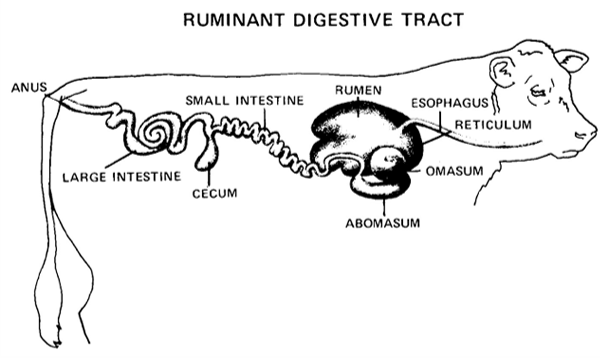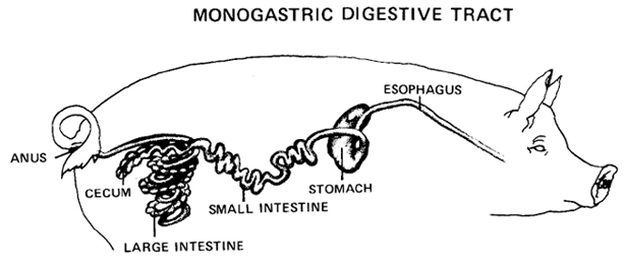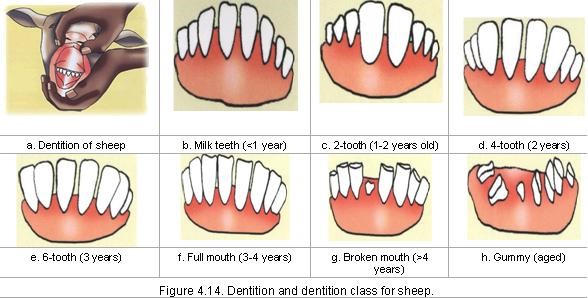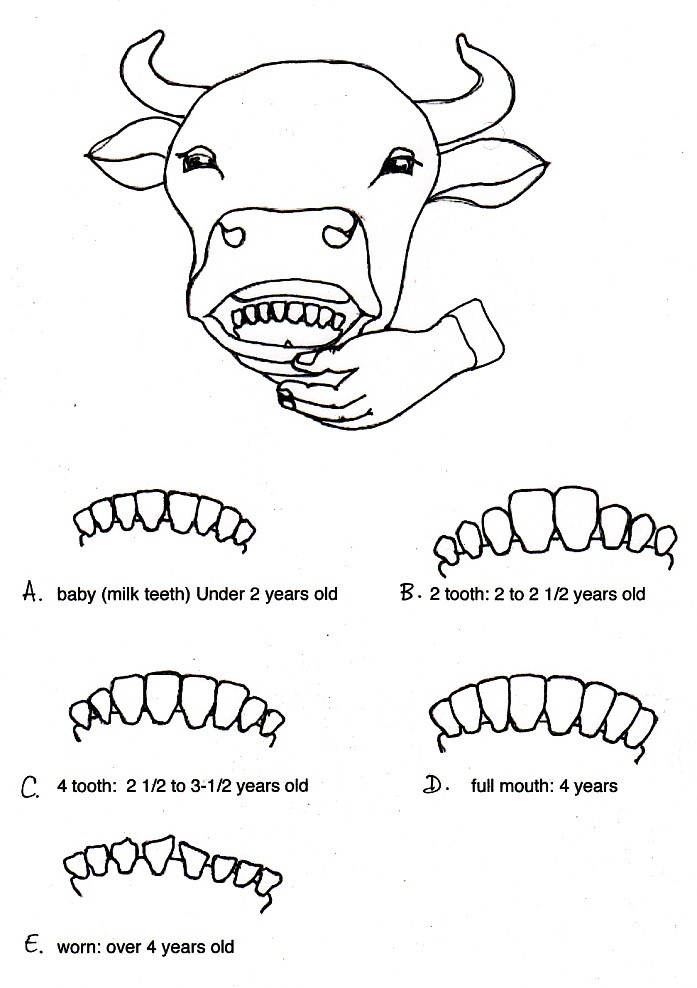Digestion is the process of breaking down feed into simple substances that can be absorbed by the body. Absorption is the taking of the digested parts of the feed into the bloodstream. The digestive system consists of the parts of the body involved in chewing and digesting feed. This system also moves the digested feed through the animal’s body and absorbs the products of digestion. Different species of animals are better able to digest certain types of feed than others. This difference occurs because of the various types of digestive systems found in animals. There are four basic types of digestive systems: monogastric, avian, ruminant, and pseudo-ruminant.
The ruminant digestive system has a large stomach divided into four compartments - the rumen, the reticulum, the omasum, and the abomasum. The ruminant digestive system is found in cattle, sheep, goats, and deer. Ruminant animals eat feed rations that are high in roughages and low in concentrates.
A monogastric digestive system has one simple stomach. The stomach secretes acid, resulting in a low pH of 1.5 to 2.5. The low pH destroys most bacteria and begins to break down the feed materials. Animals with this type of digestive system are better adapted to eat rations high in concentrates. Concentrates are highly digestible feedstuffs that are high in energy and low in fibre. Concentrates are typically 80 to 90 percent digestible. Common concentrates are cereal grains and oil meals. Cereal grains include corn, wheat, barley, and oats. Oil meals include soybean meal, linseed meal, and cottonseed meal. Examples of monogastric animals are hogs, cats, dogs, and humans.
Types of Digestive Systems
Regarding the digestive system, the domestic animals are classified into two main groups:
Monogastric (“one stomach”)
Monogastric (Non-ruminants) such as pigs, dogs and cats have a simple stomach, which can hold relatively little food, and they must therefore take in food in a concentrated form. The digestive process is totally dependent on acids and enzymes. They do not however, have an enzyme that can digest cellulose, so this substance cannot be utilised by these animals.



The Stomach of a Monogastric
Herbivores
Non-ruminants e.g., the equine family: The horse has a relatively small stomach, but its large intestine (caecum) can accommodate a large volume of food. Cellulose digestion takes place under the influence of micro-organisms in the caecum of the horse.
Ruminants e.g., cattle and sheep: Food reaches the rumen where digestion takes place under the influence of micro-organisms. The nutritive value of grass is relatively low, so the herbivore is forced to take in large quantities of it. The end products of digestion by the micro-organisms are of great importance to these animals.

The digestive stomach and lower digestive tract of cattle

The digestive stomach and lower digestive tract of a sheep
The Organs And Structures Of The Digestive Tract
Lips and Tongue
In Horses: The lips are strong, sensitive and mobile. During grazing, the lips collect the grass, which is then cut by the incisor teeth. When feeding on concentrates the tongue is also utilised to collect the food.
In Cattle: The lips have very limited mobility. The tongue has hard protrusions pointing backwards on its dorsal surface. The tongue is curled around the grass and brought into the mouth where it is pressed against the dental pad by the incisors. The incisor teeth cut off the grass with a quick upward jerk of the head.
In Sheep: Sheep have split upper lips, which make short grazing possible. The grass is taken between the incisors and dental plate and cut off with an upward jerk of the head. The upper lip of goats is not split but flexible to allow for browsing.
Teeth
The teeth are classified as follows:
- Incisors
- Canines
- Premolars
- Molars
The function of the incisors is to cut the food. In carnivores, the canine teeth help to grip the food or to tear it off. The function of the molars and premolars is to chew food to a fine consistency. During grazing ruminants do not chew their food thoroughly but swallow it after a few cursory chews. Later, when chewing the cud (rumination), the molars and premolars are used.
The mastication of food is necessary to:
- Expose a greater surface of the food to digestive enzymes in the stomach and small intestine to improve digestion;
- To thoroughly soak it with saliva and thus facilitate swallowing.
By examining the teeth of an animal, the age (in years and/or months) can be determined. It cannot, however, be determined with absolute accuracy. Various changeable factors influence the eruption of both temporary and permanent teeth as well as the wear of the teeth. In general, the temporary deciduous incisor can be distinguished from the permanent incisors by the following.
Each temporary incisor has:
- A definite neck
- Is smaller, smoother and whiter
- Has various ridges and shallow grooves while the permanent incisors only have one or two clear grooves.

Dentation of Sheep

Dentation of Cattle
In the following table, the average age of teeth eruption in the various domestic animals is given.
|
Tooth |
Horse |
Cattle |
Sheep, Goat |
Pig |
Dog |
|
Di 1 |
Birth – 1 week |
Before birth |
Birth – 1 week |
2-4 weeks |
4-5 weeks |
|
Di 2 |
4-6 weeks |
Before birth |
2 – 3 weeks |
6-12 weeks |
4-5 weeks |
|
Di 3 |
6-9 months |
Birth – 1 week |
2 – 3 weeks |
Before birth |
5-6 weeks |
|
Di 4 |
- |
Birth – 2 weeks |
3 – 4 weeks |
- |
- |
|
I 1 |
2 ½ - 3 years |
1,5 – 2 years |
1 – 1,5 weeks |
1 year |
4-5 months |
|
I 2 |
31/2years |
2- 2,5 years |
1,5 – 2 years |
16-20 months |
4-5 months |
|
I 3 |
41/2years |
3 years |
2,5 – 3 years |
- |
- |
|
I 4 |
- |
3,5 – 4 years |
3,5 – 4 years |
- |
- |
|
Dc |
Does not erupt |
- |
- |
Before birth |
3-4 weeks |
|
C |
3 |
- |
- |
6-10 months |
5-6 months |
|
Dp2 |
Birth – 2 weeks |
Birth – 3 weeks |
Birth – 4 weeks |
5-7 weeks |
4-6 weeks |
|
Dp3 |
Birth – 2 weeks |
Birth – 3 weeks |
Birth – 4 weeks |
1-4 weeks |
4-6 weeks |
|
Dp4 |
Birth – 2 weeks |
Birth – 3 weeks |
Birth – 4 weeks |
1-4 weeks |
6-8 weeks |
|
P1 |
5-6 months |
- |
- |
5 months |
4-5 months |
|
P2 |
2 ½years |
2 – 2,5 weeks |
1,5 – 2 years |
12 – 15 months |
5-6 months |
|
P4 |
4 years |
2,5 – 3 years |
1,5 – 2 years |
12 - 15 months |
5-6 months |
|
M1 |
9-12 months |
5 – 6 months |
3 – 5 months |
4 – 6 months |
4-5 months |
|
M2 |
2 years |
1 – 1,5 years |
9 – 12 months |
8-12 months |
5-6 months |
|
M3 |
3 ½- 4 years |
2 – 2,5 years |
1,5 – 2 years |
18 – 20 months |
6-7 months |
The average age of teeth eruption in the various domestic animals
Key: Di = Deciduous incisor; I = Permanent incisor; Dc = Deciduous canine; C = Permanent canine; Dp = Deciduous premolar; P = Permanent premolar; M = Molar
Salivary Glands
The salivary glands secrete the fluids, which mix with food during the mastication process, and this facilitates swallowing. Ruminants secrete large volumes of saliva (cattle approximately 55 litres per day). This saliva contains sodium bicarbonate which serves to neutralise the acids formed in the forestomach. The saliva of humans and pigs contains the enzyme ptyalin, which breaks down carbohydrates to maltose. Because ptyalin is active only in an alkaline medium, its action is inhibited almost immediately in the acid medium of the stomach. This enzyme thus has limited significance to digestion.
Oesophagus
The oesophagus connects the mouth cavity and stomach. It is a tubular structure lined on the inside by a mucous membrane, which again is surrounded by involuntary muscle.
Stomach
The stomach has two parts:
Simple Stomach
The functions of the simple stomach are as follows:
- Digestive processes under acid conditions.
- Produces the “intrinsic factor” necessary for the absorption of vitamin B12by the small intestine.
The stomach wall is lined with a membrane containing many small glands. These glands are responsible for the secretion of hydrochloric acid, which creates acid conditions in the stomach. Other glands in the stomach wall secrete various digestive enzymes.
Compound Stomach (Ruminants)
In the stomach of the ruminant four definite compartments occur i.e. the rumen, reticulum, omasum and abomasum. The first three develop as evaginations of the oesophagus whilst the abomasum can be likened to a simple stomach. Secretions of the abomasum also resemble that of the simple stomach.
Evagination: An outpouching of a layer or part of (in this case the oesophagus).
Small Intestine
The ducts of the pancreas and gall bladder open into the small intestine near the junction of the stomach and small intestine. The small intestine consists of the duodenum, jejunum and ileum and goes over the large intestine at the ileo-caecal valve. As a rule, the length of the small intestine is approximately 7 metres long. In ruminants, the small intestine can be much longer between 25 to 28 meters in sheep.
Large Intestine
Except in the horse, in which cellulose digestion takes place in the large intestine, water, which is necessary for the digestive processes, is absorbed here mainly in the caecum. The function of the last part of the large intestine i.e., the rectum is mainly to collect faeces before it is passed out through the anus.
Click here to view a video that explains the sheep's digestive system.